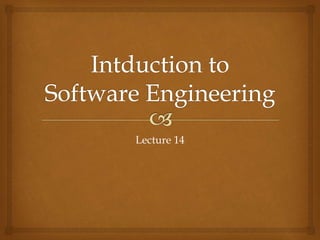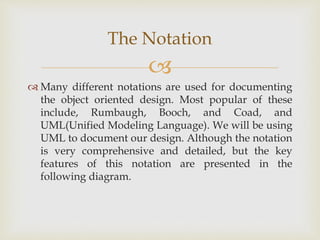Lecture 14
- 1. Lecture 14
- 2. ï ï Many different notations are used for documenting the object oriented design. Most popular of these include, Rumbaugh, Booch, and Coad, and UML(Unified Modeling Language). We will be using UML to document our design. Although the notation is very comprehensive and detailed, but the key features of this notation are presented in the following diagram. The Notation
- 3. ï UML Object Model Notation
- 4. ï ï In the case of action-oriented approach, data is decomposed according to functionality requirements. That is, decomposition revolves around function. In the OO approach, decomposition of a problem revolves around data. Action-oriented paradigm focuses only on the functionality of a system and typically ignores the data until it is required. Object- oriented paradigm focuses both on the functionality and the data at the same time. The basic difference between these two is decentralized control mechanism versus centralized control mechanism respectively. Decentralization gives OO the ability to handle essential complexity better than action-oriented approach. ï This difference is elaborated with the help of the following diagram: Object vs Action Oriented
- 5. ï Object vs Action Oriented
- 6. ï ï In this diagram, the ovals depict the function while rectangles/squares depict data. Since a function contains dynamic information while data contains only static information, if the function and data are managed separately, the required data components can be found by scanning a function but the functions that use a particular data cannot be found by just looking at the data. That is, the function knows about the data it needs to use but the data do not know about the functions using it. That means, it is easy to make a change in a function since we would know which data components would be affected by this change. On the other hand, changing a data structure would be difficult because it would not be easy to find all the functions that are using this data and hence also need to be modified. ï In the case of OO design since data and function are put together in one class, hence, in case of a change, the effected components can be identified easily and the effect of change is localized. Therefore, maintenance becomes relatively easy as compared to function-oriented approach. Object vs Action Oriented
- 8. ï Let us assume that the circles represent sets of functions and rectangles represent data that these function use to carry out their operation. In the object-oriented design, the data areas that are common among different sets of functions would be spun-off into their own classes and the user function would use these data through their interfaces only. This is shown in the following diagram. Coupling and Cohesion









